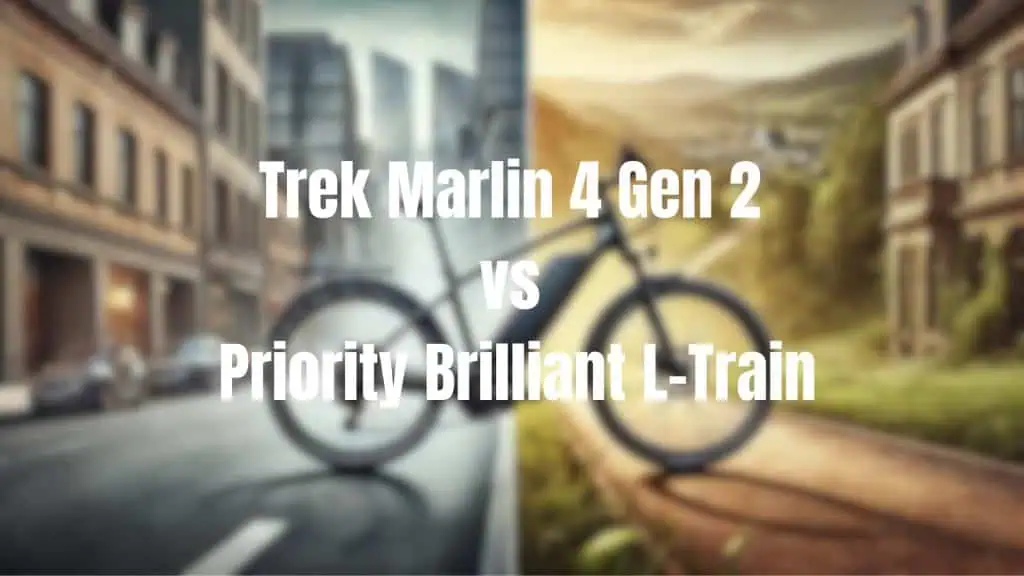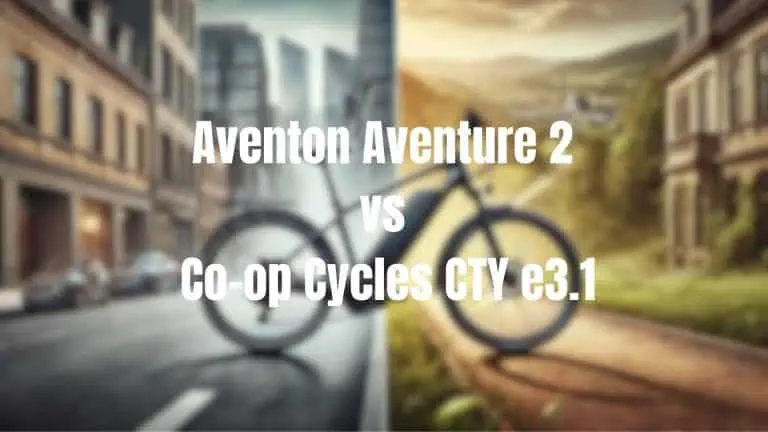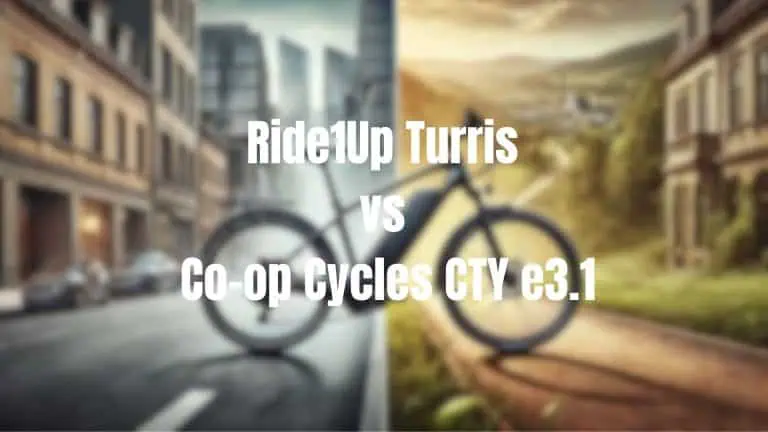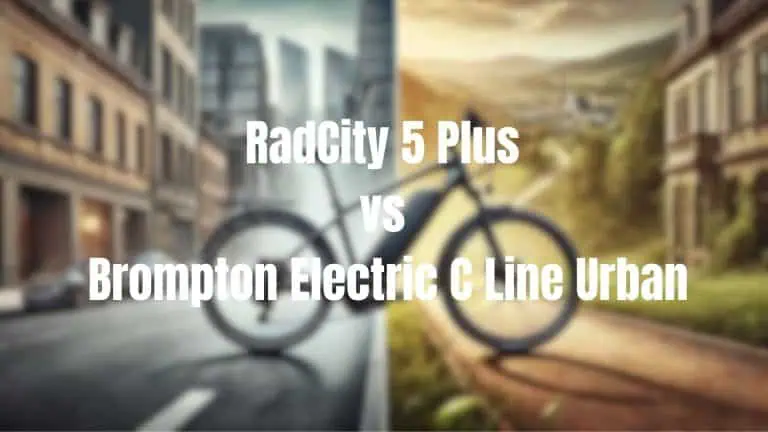Trek Marlin 4 Gen 2 vs Priority Brilliant L-Train

The Trek Marlin 4 Gen 2 and the Priority Brilliant L-Train represent two very different approaches to cycling. While the Marlin 4 is an entry-level mountain bike designed for off-road use, the L-Train is a specialized urban commuter bike. This detailed comparison will help you understand the unique characteristics of each model and determine which might better suit your cycling needs.
Comparison Table
| Feature | Trek Marlin 4 Gen 2 | Priority Brilliant L-Train |
|---|---|---|
| Price | $629.99 | $750.00 |
| Bike Type | Mountain Bike | Hybrid Bike (Commuter) |
| Frame Material | Alpha Silver Aluminum | Chromoly steel |
| Wheel Size | 29 inch | 700c |
| Suspension | Front Suspension | No Suspension |
| Drivetrain | Shimano | Shimano |
| Gearing | 21 gears | 7 gears |
| Brakes | Mechanical Disc | V-Brakes |
| Weight | 31 lbs | 30 lbs. |
Price and Value
- Trek Marlin 4 Gen 2: $629.99
- Priority Brilliant L-Train: $750.00
The Priority Brilliant L-Train is $120.01 more expensive than the Trek Marlin 4 Gen 2. This price difference reflects the L-Train’s specialized features, particularly its belt drive system and focus on urban commuting.
The Marlin 4, priced lower, offers an entry-level mountain bike suitable for off-road adventures and trail riding.
The L-Train’s higher price is justified by its unique drivetrain and focus on low-maintenance design, which could provide long-term value for dedicated commuters.
Bike Type and Frame Material
- Trek Marlin 4 Gen 2: Mountain Bike, Alpha Silver Aluminum
The Marlin 4 uses Trek’s Alpha Silver Aluminum, which offers a good balance of strength, light weight, and affordability. The mountain bike design is optimized for off-road use, with geometry suited for trail riding. - Priority Brilliant L-Train: Hybrid Bike (Commuter), Chromoly steel
The L-Train uses a chromoly steel frame, known for its durability, comfort, and ability to absorb road vibrations. It’s designed specifically as a commuter bike, with geometry optimized for urban riding.
The choice of frame material significantly impacts the ride quality. The Marlin 4’s aluminum frame will likely feel more responsive and suited for off-road use, while the L-Train’s steel frame may offer a smoother, more comfortable ride on urban streets.
Wheel Size
- Trek Marlin 4 Gen 2: 29 inch
- Priority Brilliant L-Train: 700c
The Marlin 4’s 29-inch wheels offer excellent roll-over ability, making them popular for trail riding and off-road use. They’re typically paired with wider, knobby tires for better traction on varied terrain.
The L-Train’s 700c wheels are standard for road and hybrid bikes, providing good rolling efficiency and speed on paved surfaces. They’re likely paired with narrower, smoother tires for urban use.
Suspension
- Trek Marlin 4 Gen 2: Front Suspension
- Priority Brilliant L-Train: No Suspension
This is a significant difference reflecting the bikes’ intended uses. The Marlin 4’s front suspension fork is designed to absorb impacts and vibrations from rough trails, providing more comfort and control in off-road conditions.
The L-Train’s rigid fork keeps the bike lighter and more efficient on smooth urban surfaces. The lack of suspension also means fewer moving parts and less maintenance, which aligns with its commuter-focused design.
Drivetrain and Gearing
- Trek Marlin 4 Gen 2: Shimano, 21 gears
The Marlin 4 uses a traditional chain drive with a Shimano drivetrain offering 21 gears. This wide range of gears is beneficial for tackling varied off-road terrain. - Priority Brilliant L-Train: Shimano, 7 gears
The L-Train features a belt drive system with a Shimano Nexus 7-speed internal gear hub. This system offers several advantages for urban riding: - Lower maintenance (no need to lubricate)
- Cleaner operation (no grease to get on clothes)
- Quieter ride
- Longer lifespan than traditional chains
While the L-Train offers fewer gears, the internal gear hub provides smooth shifting and is well-suited for urban riding conditions.
Brakes
- Trek Marlin 4 Gen 2: Mechanical Disc
- Priority Brilliant L-Train: V-Brakes
The Marlin 4’s mechanical disc brakes offer good stopping power and performance in various conditions, including wet and muddy trails.
The L-Train’s V-Brakes are simpler, lighter, and adequate for most urban riding conditions. However, they may not perform as well as disc brakes in wet conditions or on steep descents.
Weight
- Trek Marlin 4 Gen 2: 31 lbs
- Priority Brilliant L-Train: 30 lbs.
Despite their very different designs, these bikes are surprisingly close in weight. The Marlin 4’s slightly higher weight is likely due to its front suspension and more robust frame designed for off-road use.
Which is Better?
The choice between the Trek Marlin 4 Gen 2 and the Priority Brilliant L-Train depends entirely on your intended use:
- Terrain: If you plan to ride primarily off-road on trails, the Marlin 4 is clearly the better choice. If your riding is exclusively on urban streets and paved paths, the L-Train is more suitable.
- Maintenance: If you prioritize low maintenance, the L-Train’s belt drive and internal gear hub system is a significant advantage for urban commuting.
- Versatility: The Marlin 4, with its wider range of gears and front suspension, offers more versatility for varied terrain.
- Commuting Focus: The L-Train is specifically designed for commuting, with features that cater to daily urban riders. If your primary use is commuting, these features could be very beneficial.
- Off-Road Capability: If you have any interest in trail riding or off-road use, the Marlin 4 is the only suitable option of these two.
In conclusion, the Trek Marlin 4 Gen 2 is the better choice for riders who want to explore off-road trails or need a bike capable of handling both paved and unpaved surfaces. Its front suspension, wide gear range, and robust design make it suitable for beginners looking to get into mountain biking.
The Priority Brilliant L-Train is ideal for dedicated urban commuters who prioritize low maintenance and efficiency on paved roads. Its belt drive system, internal gear hub, and commuter-oriented design make it a reliable, clean, and quiet option for daily riding in the city.
Consider your primary riding purpose, the terrain of your typical routes, your maintenance preferences, and your budget when making your decision. These bikes are designed for very different uses, so your intended type of riding should be the primary factor in your choice.





